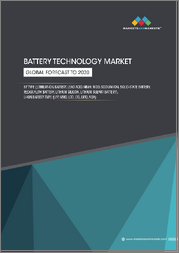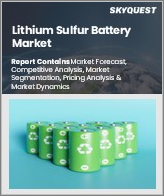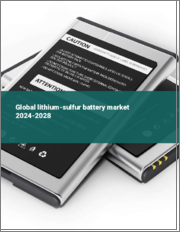
|
시장보고서
상품코드
1782547
세계의 자동차용 리튬 황 배터리 시장 조사 보고서 : 산업 분석, 규모, 점유율, 성장, 동향, 예측(2025-2033년)Global Automotive Lithium-Sulfur Battery Market Research Report- Industry Analysis, Size, Share, Growth, Trends and Forecast 2025 to 2033 |
||||||
세계의 자동차용 리튬 황 배터리 시장 규모는 2024년 3억 4,841만 달러에서 2033년에는 28억 4,106만 달러로 성장하며, 2026-2033년의 예측 기간 중 26.26%의 견고한 연평균 성장률(CAGR)을 보일 것으로 예측됩니다.
전기자동차(EV)의 고성능 에너지 저장 솔루션에 대한 수요가 지속적으로 증가함에 따라 자동차용 리튬유황 배터리 시장은 큰 성장이 예상됩니다. 리튬황 배터리는 기존 리튬이온 배터리에 비해 높은 에너지 밀도, 저렴한 비용, 지속가능성 향상 등 몇 가지 장점이 있습니다. 전기자동차의 주행거리 연장과 배터리 비용 절감에 대한 관심이 높아지고 있는 가운데, 리튬유황 기술은 차세대 에너지 저장 시스템의 유망 대안으로 주목받고 있습니다. 시장의 발전과 함께 리튬유황전지 관련 기술적 과제를 극복하고 그 잠재력을 극대화하기 위해서는 연구개발에 집중하는 것이 매우 중요합니다.
또한 배터리 기술의 발전은 자동차 용도의 리튬유황 배터리의 성능과 실현 가능성을 높이고 있습니다. 연구진은 이러한 배터리의 사이클 수명과 안정성을 향상시킬 수 있는 혁신적인 접근법을 모색하고 있으며, 폴리설파이드의 용해 및 전극의 열화 등의 문제를 해결하고 있습니다. 첨단 소재와 나노테크놀러지의 통합은 보다 효율적이고 내구성이 뛰어난 리튬유황 배터리 시스템을 개발할 수 있는 것으로 주목받고 있습니다. 자동차용 리튬유황 배터리 시장이 계속 성장함에 따라 기술 혁신과 기술 진보에 중점을 두는 것은 미래의 궤도를 형성하는 데 매우 중요한 역할을 할 것으로 보입니다.
또한 지속가능성과 환경에 대한 책임에 대한 관심이 높아지면서 자동차용 리튬유황 배터리 시장에도 영향을 미치고 있습니다. 소비자와 제조업체 모두 환경 친화적인 솔루션을 우선시하므로 리튬 황 배터리는 풍부하고 독성이 적은 재료를 사용할 수 있으므로 에너지 저장의 미래에 매력적인 선택이 될 수 있습니다. 이러한 지속가능성으로의 전환은 제조업체들이 환경 목표에 부합하는 리튬유황 배터리를 개발하기 위한 연구개발에 투자하도록 유도하고 있습니다. 따라서 자동차 리튬황 배터리 시장의 미래는 기술 혁신, 지속가능성, 그리고 운송의 전기화를 지원하는 에너지 저장 기술 발전에 대한 헌신으로 특징지어질 수 있습니다.
당사의 보고서는 고객에게 다양한 산업과 시장에 대한 종합적이고 실용적인 인사이트를 제공하기 위해 세심하게 작성되었습니다. 각 보고서는 시장 상황을 완전히 이해하기 위해 몇 가지 중요한 요소를 포함하고 있습니다.
시장 개요: 정의, 분류, 산업 현황 등 시장에 대한 자세한 소개.
시장 역학: 시장 성장에 영향을 미치는 주요 촉진요인, 억제요인, 기회 및 과제를 상세하게 분석합니다. 이 섹션에서는 기술 발전, 규제 변화, 새로운 동향 등의 요인을 살펴봅니다.
세분화 분석 : 제품 유형, 용도, 최종사용자, 지역 등의 기준에 따라 시장을 명확한 부문으로 세분화합니다. 이 분석을 통해 각 부문의 실적과 미래성을 파악할 수 있습니다.
경쟁 구도: 시장 점유율, 제품 포트폴리오, 전략적 구상, 재무 실적 등 주요 시장 기업의 종합적인 평가. 주요 기업이 채택하고 있는 경쟁 역학 및 주요 전략에 대한 인사이트을 제공합니다.
시장 예측 : 과거 데이터와 현재 시장 상황을 바탕으로 일정 기간 시장 규모와 성장 추세를 예측합니다. 여기에는 정량적 분석과 미래 시장 궤적을 보여주는 그래프 표시가 포함됩니다.
지역별 분석 : 지역별 시장 실적을 평가하고 주요 시장 및 지역 동향을 파악합니다. 지역 시장 역학 및 비즈니스 기회를 이해하는 데 도움이 됩니다.
새로운 동향과 기회 : 현재 시장 동향과 새로운 시장 동향, 기술 혁신, 잠재적 투자 대상 분야를 파악합니다. 미래 시장 개발과 성장 전망에 대한 인사이트를 제공합니다.
목차
제1장 서문
제2장 개요
- 시장의 하이라이트
- 세계 시장 스냅숏
제3장 자동차용 리튬 황 배터리 산업 분석
- 서론 : 시장 역학
- 시장 성장 촉진요인
- 시장 성장 억제요인
- 시장 기회
- 업계 동향
- Porter's Five Forces 분석
- 시장의 매력 분석
제4장 밸류체인 분석
- 밸류체인 분석
- 원재료 분석
- 원재료 리스트
- 원재료 제조업체 리스트
- 주요 원재료의 가격 동향
- 잠재적 바이어 리스트
- 마케팅 채널
- 다이렉트 마케팅
- 인다이렉트 마케팅
- 마케팅 채널 발전 동향
제5장 세계의 자동차용 리튬 황 배터리 시장 분석 : 배터리 용량별
- 개요 : 배터리 용량별
- 실적·예측 데이터 분석 : 배터리 용량별
- 500mAh 미만
- 501-1000mAh 미만
- 1000mAh 이상
제6장 세계의 자동차용 리튬 황 배터리 시장 분석 : 추진력별
- 개요 : 추진력별
- 실적·예측 데이터 분석 : 추진력별
- 배터리 전기자동차(BEV)
- 하이브리드차(HEV)
제7장 세계의 자동차용 리튬 황 배터리 시장 분석 : 차종별
- 개요 : 차종별
- 실적·예측 데이터 분석 : 차종별
- 이륜차
- 승용차(해치백, 세단, 유틸리티 차량)
- 소형 상용차
- 대형 상용차
- 버스·객차
제8장 세계의 자동차용 리튬 황 배터리 시장 분석 : 지역별
- 지역별 전망
- 서론
- 북미의 판매 분석
- 개요, 실적과 예측
- 북미 : 부문별
- 북미 : 국가별
- 미국
- 캐나다
- 멕시코
- 유럽의 판매 분석
- 개요, 실적과 예측
- 유럽 : 부문별
- 유럽 : 국가별
- 영국
- 프랑스
- 독일
- 이탈리아
- 러시아
- 기타 유럽
- 아시아태평양의 판매 분석
- 개요, 실적과 예측
- 아시아태평양 : 부문별
- 아시아태평양 : 국가별
- 중국
- 인도
- 일본
- 한국
- 호주
- 동남아시아
- 기타 아시아태평양
- 라틴아메리카의 판매 분석
- 개요, 실적과 예측
- 라틴아메리카 : 부문별
- 라틴아메리카 : 국가별
- 브라질
- 아르헨티나
- 페루
- 칠레
- 기타 라틴아메리카
- 중동 및 아프리카의 판매 분석
- 개요, 실적과 예측
- 중동 및 아프리카 : 부문별
- 중동 및 아프리카 : 국가별
- 사우디아라비아
- 아랍에미리트
- 이스라엘
- 남아프리카공화국
- 기타 중동 및 아프리카
제9장 자동차용 리튬 황 배터리 기업의 경쟁 구도
- 자동차용 리튬 황 배터리 시장 경쟁
- 제휴·협력·합의
- 합병·인수
- 신제품 발표
- 기타 개발
제10장 기업 개요
- 상위 기업의 시장 점유율 분석
- 시장 집중도
- Oxis Energy
- Sion Power
- Advanced Energy Materials
- Ilika PLC
- Johnson Matthey
- LG Chem
- Morrow Batteries
- NOHMs Technologies
- PolyPlus
- Williams Advanced
Global Automotive Lithium-Sulfur Battery Market size is anticipated to grow from USD 348.41 Million in 2024 to USD 2841.06 Million by 2033, showcasing a robust Compound Annual Growth Rate (CAGR) of 26.26% during the forecast period of 2026 to 2033.
The automotive lithium-sulfur battery market is poised for significant growth as the demand for high-performance energy storage solutions in electric vehicles (EVs) continues to rise. Lithium-sulfur batteries offer several advantages over traditional lithium-ion batteries, including higher energy density, lower cost, and improved sustainability. With the increasing focus on extending the range of electric vehicles and reducing battery costs, lithium-sulfur technology is gaining traction as a promising alternative for next-generation energy storage systems. As the market evolves, the emphasis on research and development will be crucial in overcoming the technical challenges associated with lithium-sulfur batteries and unlocking their full potential.
Moreover, advancements in battery technology are enhancing the performance and viability of lithium-sulfur batteries for automotive applications. Researchers are exploring innovative approaches to improve the cycle life and stability of these batteries, addressing issues such as polysulfide dissolution and electrode degradation. The integration of advanced materials and nanotechnology is also gaining traction, enabling the development of more efficient and durable lithium-sulfur battery systems. As the automotive lithium-sulfur battery market continues to grow, the focus on innovation and technological advancements will play a vital role in shaping its future trajectory.
In addition, the growing emphasis on sustainability and environmental responsibility is influencing the automotive lithium-sulfur battery market. As consumers and manufacturers alike prioritize eco-friendly solutions, the potential for lithium-sulfur batteries to utilize abundant and less toxic materials makes them an attractive option for the future of energy storage. This shift towards sustainability is prompting manufacturers to invest in research and development to create lithium-sulfur batteries that align with environmental goals. The future of the automotive lithium-sulfur battery market is thus characterized by innovation, sustainability, and a commitment to advancing energy storage technologies to support the electrification of transportation.
Our reports are meticulously crafted to provide clients with comprehensive and actionable insights into various industries and markets. Each report encompasses several critical components to ensure a thorough understanding of the market landscape:
Market Overview: A detailed introduction to the market, including definitions, classifications, and an overview of the industry's current state.
Market Dynamics: In-depth analysis of key drivers, restraints, opportunities, and challenges influencing market growth. This section examines factors such as technological advancements, regulatory changes, and emerging trends.
Segmentation Analysis: Breakdown of the market into distinct segments based on criteria like product type, application, end-user, and geography. This analysis highlights the performance and potential of each segment.
Competitive Landscape: Comprehensive assessment of major market players, including their market share, product portfolio, strategic initiatives, and financial performance. This section provides insights into the competitive dynamics and key strategies adopted by leading companies.
Market Forecast: Projections of market size and growth trends over a specified period, based on historical data and current market conditions. This includes quantitative analyses and graphical representations to illustrate future market trajectories.
Regional Analysis: Evaluation of market performance across different geographical regions, identifying key markets and regional trends. This helps in understanding regional market dynamics and opportunities.
Emerging Trends and Opportunities: Identification of current and emerging market trends, technological innovations, and potential areas for investment. This section offers insights into future market developments and growth prospects.
SEGMENTATION COVERED IN THE REPORT
By Battery Capacity
- Less than 500 mAh
- Between 501 to 1000 mAh
- More than 1000 mAh
By Propulsion
- Battery Electric Vehicle (BEV)
- Hybrid Electric Vehicle (HEV)
By Vehicle Type
- Two-Wheeler
- Passenger Vehicle (Hatchback, Sedan, Utility Vehicles)
- Light Commercial Vehicle
- Heavy Commercial Vehicle
- Buses and Coaches
- COMPANIES PROFILED
- Oxis Energy
- Sion Power
- Advanced Energy Materials
- Ilika PLC
- Johnson Matthey
- LG Chem
- Morrow Batteries
- NOHMs Technologies
- PolyPlus
- Williams Advanced.
- The above list can be customized.
TABLE OF CONTENTS
1. PREFACE
- 1.1. Report Description
- 1.1.1 Objective
- 1.1.2 Target Audience
- 1.1.3 Unique Selling Proposition (USP) & offerings
- 1.2. Research Scope
- 1.3. Research Methodology
- 1.3.1 Market Research Process
- 1.3.2 Market Research Methodology
2. EXECUTIVE SUMMARY
- 2.1. Highlights of Market
- 2.2. Global Market Snapshot
3. AUTOMOTIVE LITHIUM-SULFUR BATTERY INDUSTRY ANALYSIS
- 3.1. Introduction - Market Dynamics
- 3.2. Market Drivers
- 3.3. Market Restraints
- 3.4. Opportunities
- 3.5. Industry Trends
- 3.6. Porter's Five Force Analysis
- 3.7. Market Attractiveness Analysis
- 3.7.1 Market Attractiveness Analysis By Battery Capacity
- 3.7.2 Market Attractiveness Analysis By Propulsion
- 3.7.3 Market Attractiveness Analysis By Vehicle Type
- 3.7.4 Market Attractiveness Analysis By Regions
4. VALUE CHAIN ANALYSIS
- 4.1. Value Chain Analysis
- 4.2. Raw Material Analysis
- 4.2.1 List of Raw Materials
- 4.2.2 Raw Material Manufactures List
- 4.2.3 Price Trend of Key Raw Materials
- 4.3. List of Potential Buyers
- 4.4. Marketing Channel
- 4.4.1 Direct Marketing
- 4.4.2 Indirect Marketing
- 4.4.3 Marketing Channel Development Trend
5. GLOBAL AUTOMOTIVE LITHIUM-SULFUR BATTERY MARKET ANALYSIS BY BATTERY CAPACITY
- 5.1. Overview By Battery Capacity
- 5.2. Historical and Forecast Data Analysis By Battery Capacity
- 5.3. Less than 500 mAh Historic and Forecast Sales By Regions
- 5.4. Between 501 to 1000 mAh Historic and Forecast Sales By Regions
- 5.5. More than 1000 mAh Historic and Forecast Sales By Regions
6. GLOBAL AUTOMOTIVE LITHIUM-SULFUR BATTERY MARKET ANALYSIS BY PROPULSION
- 6.1. Overview By Propulsion
- 6.2. Historical and Forecast Data Analysis By Propulsion
- 6.3. Battery Electric Vehicle (BEV) Historic and Forecast Sales By Regions
- 6.4. Hybrid Electric Vehicle (HEV) Historic and Forecast Sales By Regions
7. GLOBAL AUTOMOTIVE LITHIUM-SULFUR BATTERY MARKET ANALYSIS BY VEHICLE TYPE
- 7.1. Overview By Vehicle Type
- 7.2. Historical and Forecast Data Analysis By Vehicle Type
- 7.3. Two-Wheeler Historic and Forecast Sales By Regions
- 7.4. Passenger Vehicle (Hatchback, Sedan, Utility Vehicles) Historic and Forecast Sales By Regions
- 7.5. Light Commercial Vehicle Historic and Forecast Sales By Regions
- 7.6. Heavy Commercial Vehicle Historic and Forecast Sales By Regions
- 7.7. Buses and Coaches Historic and Forecast Sales By Regions
8. GLOBAL AUTOMOTIVE LITHIUM-SULFUR BATTERY MARKET ANALYSIS BY GEOGRAPHY
- 8.1. Regional Outlook
- 8.2. Introduction
- 8.3. North America Sales Analysis
- 8.3.1 Overview, Historic and Forecast Data Sales Analysis
- 8.3.2 North America By Segment Sales Analysis
- 8.3.3 North America By Country Sales Analysis
- 8.3.4 United States Sales Analysis
- 8.3.5 Canada Sales Analysis
- 8.3.6 Mexico Sales Analysis
- 8.4. Europe Sales Analysis
- 8.4.1 Overview, Historic and Forecast Data Sales Analysis
- 8.4.2 Europe By Segment Sales Analysis
- 8.4.3 Europe By Country Sales Analysis
- 8.4.4 United Kingdom Sales Analysis
- 8.4.5 France Sales Analysis
- 8.4.6 Germany Sales Analysis
- 8.4.7 Italy Sales Analysis
- 8.4.8 Russia Sales Analysis
- 8.4.9 Rest Of Europe Sales Analysis
- 8.5. Asia Pacific Sales Analysis
- 8.5.1 Overview, Historic and Forecast Data Sales Analysis
- 8.5.2 Asia Pacific By Segment Sales Analysis
- 8.5.3 Asia Pacific By Country Sales Analysis
- 8.5.4 China Sales Analysis
- 8.5.5 India Sales Analysis
- 8.5.6 Japan Sales Analysis
- 8.5.7 South Korea Sales Analysis
- 8.5.8 Australia Sales Analysis
- 8.5.9 South East Asia Sales Analysis
- 8.5.10 Rest Of Asia Pacific Sales Analysis
- 8.6. Latin America Sales Analysis
- 8.6.1 Overview, Historic and Forecast Data Sales Analysis
- 8.6.2 Latin America By Segment Sales Analysis
- 8.6.3 Latin America By Country Sales Analysis
- 8.6.4 Brazil Sales Analysis
- 8.6.5 Argentina Sales Analysis
- 8.6.6 Peru Sales Analysis
- 8.6.7 Chile Sales Analysis
- 8.6.8 Rest of Latin America Sales Analysis
- 8.7. Middle East & Africa Sales Analysis
- 8.7.1 Overview, Historic and Forecast Data Sales Analysis
- 8.7.2 Middle East & Africa By Segment Sales Analysis
- 8.7.3 Middle East & Africa By Country Sales Analysis
- 8.7.4 Saudi Arabia Sales Analysis
- 8.7.5 UAE Sales Analysis
- 8.7.6 Israel Sales Analysis
- 8.7.7 South Africa Sales Analysis
- 8.7.8 Rest Of Middle East And Africa Sales Analysis
9. COMPETITIVE LANDSCAPE OF THE AUTOMOTIVE LITHIUM-SULFUR BATTERY COMPANIES
- 9.1. Automotive Lithium-Sulfur Battery Market Competition
- 9.2. Partnership/Collaboration/Agreement
- 9.3. Merger And Acquisitions
- 9.4. New Product Launch
- 9.5. Other Developments
10. COMPANY PROFILES OF AUTOMOTIVE LITHIUM-SULFUR BATTERY INDUSTRY
- 10.1. Top Companies Market Share Analysis
- 10.2. Market Concentration Rate
- 10.3. Oxis Energy
- 10.3.1 Company Overview
- 10.3.2 Company Revenue
- 10.3.3 Products
- 10.3.4 Recent Developments
- 10.4. Sion Power
- 10.4.1 Company Overview
- 10.4.2 Company Revenue
- 10.4.3 Products
- 10.4.4 Recent Developments
- 10.5. Advanced Energy Materials
- 10.5.1 Company Overview
- 10.5.2 Company Revenue
- 10.5.3 Products
- 10.5.4 Recent Developments
- 10.6. Ilika PLC
- 10.6.1 Company Overview
- 10.6.2 Company Revenue
- 10.6.3 Products
- 10.6.4 Recent Developments
- 10.7. Johnson Matthey
- 10.7.1 Company Overview
- 10.7.2 Company Revenue
- 10.7.3 Products
- 10.7.4 Recent Developments
- 10.8. LG Chem
- 10.8.1 Company Overview
- 10.8.2 Company Revenue
- 10.8.3 Products
- 10.8.4 Recent Developments
- 10.9. Morrow Batteries
- 10.9.1 Company Overview
- 10.9.2 Company Revenue
- 10.9.3 Products
- 10.9.4 Recent Developments
- 10.10. NOHMs Technologies
- 10.10.1 Company Overview
- 10.10.2 Company Revenue
- 10.10.3 Products
- 10.10.4 Recent Developments
- 10.11. PolyPlus
- 10.11.1 Company Overview
- 10.11.2 Company Revenue
- 10.11.3 Products
- 10.11.4 Recent Developments
- 10.12. Williams Advanced
- 10.12.1 Company Overview
- 10.12.2 Company Revenue
- 10.12.3 Products
- 10.12.4 Recent Developments



















